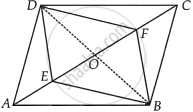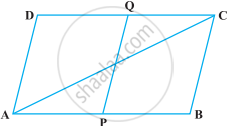Advertisements
Advertisements
प्रश्न
E and F are points on diagonal AC of a parallelogram ABCD such that AE = CF. Show that BFDE is a parallelogram.
उत्तर
Given: ABCD is a parallelogram and AE = CF
To show: OE = OF
Construction: Join BD, meet AC at point O.
Proof: Since, diagonals of a parallelogram bisect each other.

∴ OA = OC
And OD = OB
Now, OA = OC
And AE = CF ...[Given]
⇒ OA – AE = OC – CF
⇒ OE = OF
Thus, BFDE is a quadrilateral whose diagonals bisect each other.
Hence, BFDE is a parallelogram.
Hence proved.
APPEARS IN
संबंधित प्रश्न
Diagonals of a parallelogram `square`WXYZ intersect each other at point O. If ∠XYZ = 135° then what is the measure of ∠XWZ and ∠YZW?
If l(OY)= 5 cm then l(WY)= ?
Diagonals AC and BD of a parallelogram ABCD intersect each other at O. If OA = 3 cm and OD = 2 cm, determine the lengths of AC and BD.
Diagonals of a parallelogram are perpendicular to each other. Is this statement true? Give reason for your answer.
Diagonals of a quadrilateral ABCD bisect each other. If ∠A = 35º, determine ∠B.
Points P and Q have been taken on opposite sides AB and CD, respectively of a parallelogram ABCD such that AP = CQ (Figure). Show that AC and PQ bisect each other.

A diagonal of a parallelogram bisects one of its angles. Show that it is a rhombus.
In the following figure, AB || DE, AB = DE, AC || DF and AC = DF. Prove that BC || EF and BC = EF.

P and Q are points on opposite sides AD and BC of a parallelogram ABCD such that PQ passes through the point of intersection O of its diagonals AC and BD. Show that PQ is bisected at O.
If diagonals of a quadrilateral bisect each other, it must be a parallelogram.
The point of intersection of diagonals of a quadrilateral divides one diagonal in the ratio 1:2. Can it be a parallelogram? Why or why not?
